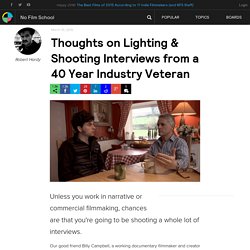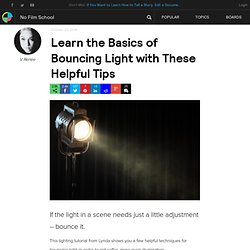

Learn How to Use a Single Softbox to Light 10 Different Scenes. Indie filmmakers typically don't have deep pockets, which is why it's so important to know how to light your scenes with as few lights as possible.

This is for several reasons: lights are expensive, DPs are expensive, and many times you're not going to have a whole lot of time or space to work with either. That's why finding a lighting solution that is as effective, unobtrusive, and inexpensive as possible is key. Sekonic's Tony Corbell walks us through how to light 10 scenes using a single light source, a softbox -- either a $180 Bowens Lumiair 80-100 Softbox or a $912 Bowens Gemini 500Pro monolight. (Technically there are more if you consider bounce cards light sources.) Check it out below: Even though this tutorial is geared toward photography there is plenty for filmmakers to learn from each lighting setup. However, keep in mind that the bigger the space your scene calls for, the more lights you'll potentially need. How To LIGHT With JUST ONE LIGHT! A Primer on Practical Lights: How Practicals Can Make Your Cinematography Come to Life. If there's one simple thing that you can do today to make your cinematography look more professional and polished, it's incorporating practical lights into your scenes.

Practical lights are, of course, traditionally defined as any light where the source is in frame. More often than not, this means lights that are built into your locations (usually ceiling fixtures), desk and floor lamps, televisions, computers, and strings of Christmas lights. It can also refer to headlights from a car and street lamps. All sorts of things can be used as practical light. Before we get into the specifics of why and how to light with practicals, here's a quick quote from Roger Deakins, taken from his fantastic online forum, about the importance of practical lighting, especially in the digital age where camera sensitivity and dynamic range are through the roof: Thoughts on Lighting & Shooting Interviews from a 40 Year Industry Veteran. Unless you work in narrative or commercial filmmaking, chances are that you're going to be shooting a whole lot of interviews.

Our good friend Billy Campbell, a working documentary filmmaker and creator of the Scorpion Light, is working on a series of lighting tutorials based on feedback from readers of this site. Recently, he's also put together another excellent educational resource for filmmakers, an interview and tutorial series with his father Douglas Campbell, a 40-year veteran of the film industry who has seen and done it all. In the first installment, the pair talk about the process of conducting and lighting an interview, which is the bread and butter of filmmakers working in documentary, corporate, and some genres of television. The key takeaway from this conversation is something that we've all heard before — content is king, and style is secondary.
An Simple Interview Setup Using Natural Light There are a few things to keep in mind when using natural light. Create 3 Atmospheres in 1 Room (& Pull Off Great Lighting SFX) with This Clever Tutorial. Learn the 'Rules' of Film Noir & How to Light It. Genres come and go, but 70 years after its birth, the "rules" of film noir have become part and parcel of the conventions of modern cinema.

Why do filmmakers come back again and again to this bleak landscape? And why are these films still popular (if they weren't, well, there wouldn't be nearly as many. QED.) And just what, precisely, are its rules -- rules so skilfully subverted by modern directors? A documentary from the BBC, originally aired in 2009, seeks to answer just that, shining a light on the dark corners of film noir.
The conventions of film noir (literally, black film, referring both to the lighting schema and the general weltanshauung of the pictures themselves) are inextricably tied in with American cinema to this day. The Quiet American - 2002 (Saigon 1952 Story) The Basics of Lighting for Film Noir. WATCHED. Filmmaking 101 - Three Point Lighting Tutorial. Learn the Basics of Bouncing Light with These Helpful Tips.
If the light in a scene needs just a little adjustment -- bounce it.

This lighting tutorial from Lynda shows you a few helpful techniques for bouncing light in order to get softer, more even illumination. Bouncing light is helpful when you just need a little adjustment to the intensity of a light, especially if you're working in a confined space and can't move the lights further away from your subject. Pros use this technique often because it softens a subject's face by diffusing light to give them a more natural, even look. Though it can certainly be used to light subjects, remember that it's also used to create atmosphere. Cinematographer Conrad Hall describes the light that is bounced off of walls, ceilings, floors, and other surfaces as "room tone," so it's important to pay close attention to not only what bounced light can do for your subjects, but what it can do to create the mood/tone/atmosphere in a particular scene.